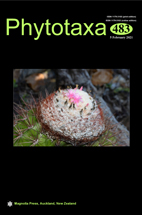Abstract
Cryptangieae is a monophyletic tribe, as asserted in a recent molecular hypothesis, but there are questions about the circumscription and relationships of its genera. We enlarged the sampling of the tribe diversity, including about 80% of known species, and provide new analyses using single and combined matrices from two chloroplast (rbcL and trnL-F) and three nuclear ribosomal (ITS, ETS and 5S-NTS) regions with Bayesian Inference to clarify these questions. We also performed character reconstruction analyses with diagnostic morphological characters, including some traditionally applied in Cryptangieae taxonomy, using parsimony methods. The molecular analyses show Lagenocarpus in the current circumscription as polyphyletic, and the need to merge Cephalocarpus and Everardia to avoid paraphyletic genera. We propose an updated circumscription following the phylogeny, including a new name to a group at generic level (Krenakia); and discuss the phylogenetic significance of the morphological characters in Cryptangieae taxonomy. Though the relationship among some genera still needs more research, the genera we propose are strongly supported clades with clear morphological synapomorphies. Additionally, we provide an identification key, a brief description of genera and a list of accepted species including the required new combinations.

